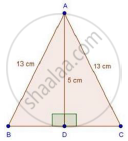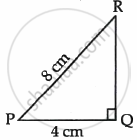Advertisements
Advertisements
प्रश्न
In an isosceles triangle ABC, if AB = AC = 13 cm and the altitude from A on BC is 5 cm, find BC.
उत्तर

In ΔADB, by Pythagoras theorem
AD2 + BD2 = 132
⇒ 25 + BD2 = 169
⇒ BD2 = 169 − 2 = 144
⇒ BD = `sqrt144` = 12 cm
In ΔADB and ΔADC
∠ADB = ∠ADC [Each 90°]
AB = AC [Each 13 cm]
AD = AD [Common]
Then, ΔADB ≅ ΔADC [By RHS condition]
∴ BD = CD = 12 cm [By c.p.c.t]
Hence, BC = 12 + 12 = 24 cm
APPEARS IN
संबंधित प्रश्न
The sides of triangle is given below. Determine it is right triangle or not.
a = 7 cm, b = 24 cm and c = 25 cm
The sides of triangle is given below. Determine it is right triangle or not.
a = 9 cm, b = l6 cm and c = 18 cm
A ladder 17 m long reaches a window of a building 15 m above the ground. Find the distance of the foot of the ladder from the building.
Each side of a rhombus is 10 cm. If one of its diagonals is 16 cm find the length of the other diagonal.
In an equilateral ΔABC, AD ⊥ BC, prove that AD2 = 3BD2.
In an equilateral triangle with side a, prove that area = `sqrt3/4` 𝑎2
Find the diagonal of a rectangle whose length is 16 cm and area is 192 sq.cm ?
Find the side and perimeter of a square whose diagonal is `13sqrt2` cm.
From given figure, In ∆ABC, AB ⊥ BC, AB = BC, AC = `2sqrt(2)` then l (AB) = ?
In the given figure, ΔPQR is a right triangle right angled at Q. If PQ = 4 cm and PR = 8 cm, then P is ______.

